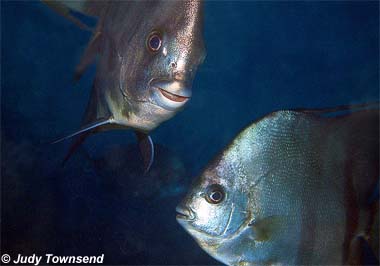
Chaetodipterus faber
This silver and black striped, disk-shaped fish schools in groups as large as 500. Although it’s the only of its family to live in the Western Atlantic, there are a few fish that look similar. The Atlantic spadefish can grow to almost 36 inches and 20 pounds. Some anglers like to catch this fish for its fighting spirit, and it is enjoyed as a food catch, but there is a risk of ciguatera poisoning from its flesh.
Order: Perciformes
Family: Ephippidae
Genus: Chaetodipterus
Species: faber
Common Names
Common names of this fish in the English language include Atlantic spadefish (named for its spade-like body shape), angelfish, Atlantic spade, butterfly fish, jackass, leathercoat, moonfish, ocean cobbler, pot cover, sea donkey, spadefish, threebanded sheephead, threetailed porgy, tripletail, white angel, and white angelfish. Other common names include Atlantisk spadefisk (Danish), carangue à slime (French), chabela (Spanish), chirivita chiva (Spanish), disque portuguais (French), enxada (Portuguese), isabelita (Spanish), paguala (Spanish), paru-branco (Portuguese), parum (Portuguese), parum-branco (Portuguese), parum-enxada (Portuguese), parum-rajado (Portuguese), peixe-enxada (Portuguese), sabaleta (Spanish), shirogane-tsubameuo (Japanese), spatenfisch (German), szpadelek karaibski (Polish), and tareira (Portuguese).
Importance to Humans
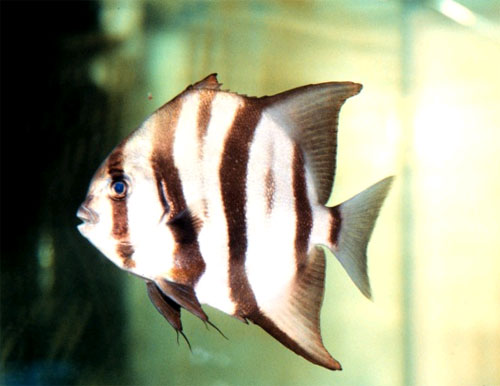
The Atlantic spadefish is of only minor commercial value. However, it is valued by recreational fishers due to its size and tenaciousness. The flesh of this fish is considered relatively good although they have been associated with ciguatera poisoning. Atlantic spadefish are often residents of large public aquarium facilites and they have been successfully reared in captivity. In their natural habitat, Atlantic spadefish often swim circles around scuba divers.
Danger to Humans
There have been reported cases of ciguatera from human consumption of Atlantic spadefish. Ciguatera poisoning is caused by dinoflagellates (microalgae) found on dead corals or macroalgae. By feeding on these corals and macroalgae, herbivorous fishes accumulate a toxin generated by these dinoflagellates. Largely a phenomenon of tropical marine environments, ciguatoxin accumulates still further in snappers and other large predatory reef species that feed on these herbivorous fishes. If accumulated levels of the toxin are great enough they can cause poisoning in humans whom consume the flesh of these fishes. Poisoned people report having gastrointestinal problems for up to several days, and a general weakness in their arms and legs. It is very rare to be afflicted with ciguatera poisoning.
Conservation
Current levels of harvest are unknown for this species, however the schooling, spawning, and feeding behavior greatly increase the potential for overfishing. There is no specific management plan for the Atlantic spadefish to monitor the harvest.
The Atlantic spadefish is not listed as endangered or vulnerable with the World Conservation Union (IUCN). The IUCN is a global union of states, governmental agencies, and non-governmental organizations in a partnership that assesses the conservation status of species.
> Check the status of the Atlantic spadefish at the IUCN website.
Geographical Distribution
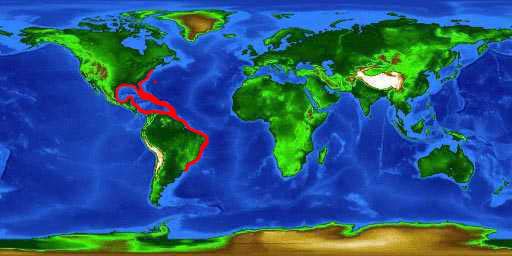
The Atlantic spadefish is the only member of the family Ephippidae to reside in the western Atlantic Ocean. It is limited in range to the Atlantic Ocean from Massachusetts (US) south to southeastern Brazil, including the northern Gulf of Mexico. It is also found off Bermuda and throughout the Caribbean.
Habitat
This schooling fish is abundant within the shallow marine and brackish waters of mangroves, beaches, harbors, and shipwrecks. It is found at depths of 3-35 m. Juvenile Atlantic spadefish reside in very shallow water, often swimming at an angle, disguising themselves as dead leaves or mangrove pods to avoid predation. Adults often school in groups of up to 500 individuals.
Biology
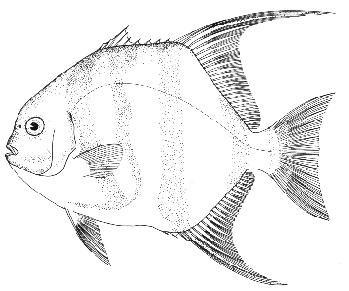
Distinctive Features
The Atlantic spadefish is a deep-bodied, compressed disk-shaped fish with a blunt snout. The mouth is small with the maxilla extending below the nostrils in adult individuals. The head and fins are scaled and the opercle terminates in an obtuse point above the origin of the pectoral fins. The first and second dorsal fins are separated; the anterior rays of the second dorsal fin as well as the anal fin are elongated. The margin of the caudal fin is concave.
There are no other native fishes in the same geographical area that the Atlantic spadefish might be confused with, however it is often mistakenly referred to as an angelfish. Angelfish are easily distinguished since they have only one dorsal fin. Recently, the orbiculate batfish (Platax orbicularis) has been reported as an invasive species in the Florida Keys. In 2000, three individuals were seen on Molasses Reef off Key Largo. Two of these fish were captured and sent to the New England Aquarium (Boston). Later, in 2004, two more individuals were captured in the same area and sent to the Tampa Aquarium in Florida. An interesting note: these fish were observed schooling with Atlantic spadefish. These fish, native to the Pacific Ocean, were probably released by home aquarists when they grew too large for their aquariums.
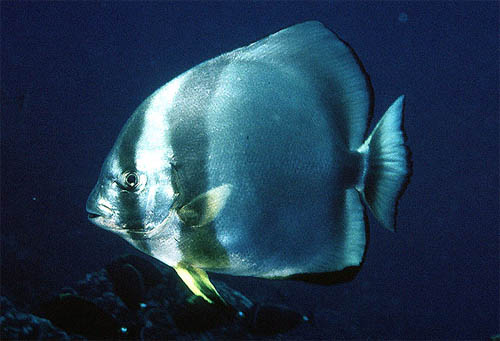
Coloration
This fish is silvery in color with 4-6 black vertical bands on each side of the body. These bands sometimes fade or become obscure in larger fish. The first band runs through the eye and the last band runs through the caudal peduncle. Juveniles are dark brown to black with some lighter mottling and appear similar to dark leaves in the water. The adult coloration is similar to that of the sheepshead (Archosargus probatocephalus), however the Atlantic spadefish has a shorter snout, rounder overall body shape and larger soft dorsal and anal fins than the sheepshead. Also, the black vertical bands on the sheepshead do not fade to the extent they do on the spadefish.
Dentition
This spadefish has small, brush-like teeth arranged in bands. There are no teeth on the roof of mouth.
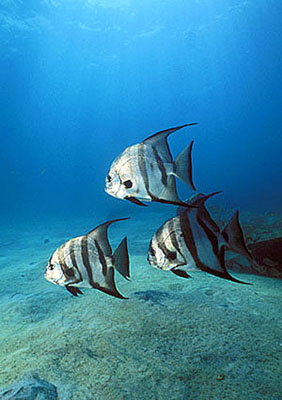
Size, Age, and Growth
The Atlantic spadefish reaches a maximum total length of 35.8 inches (91.0 cm) and a maximum reported weight of 19.8 pounds (9 kg). Both sexes are mature at approximately one year of age. The expected lifespan is 8-10 years.
Food Habits
Benthic invertebrates including crustaceans, mollusks, annelids, sponges, and cnidarians are preyed upon by the bottom feeding Atlantic spadefish. This fish may also feed occasionally on plankton as well as nibble on jellyfish tentacles. Feeding occurs throughout the day with a peak around midday.
Reproduction
Spawning season runs from May through September on the inner shelf off the coast of the US. A single female may release up to one million eggs each spawning season. The eggs are small and buoyant, hatching after approximately 24 hours. The newly hatched larvae feed on a yolk sac for the first two days of life, after which they begin to actively feed. Approximately 28 hours after hatching, the pectoral rays are well developed and the caudal rays are present. Traces of reddish colored pigment also begin to appear along the dorsal and lateral sides of the fish. As the larvae reach the juvenile life stage, the teeth and lateral line appear. Upon reaching 20mm in length, three of the black bands become prominent. The fourth bar appears as the fish reaches 30mm and the fifth appears when the fish reaches 40-50 mm in length.
Predators
Predators of the Atlantic spadefish include sharks such as the smalltail shark (Carcharhinus porosus) as well as large fishes including the tripletail (Lobotes surinamensis).
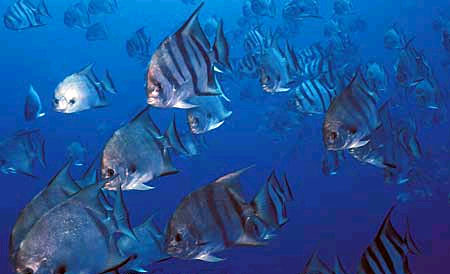
Parasites
Parasites of the Atlantic spadefish include digeneans and monogeneans. These include Parancylodiscoides caballerobravorum sp. nov which infest the gill filaments and Sprostoniella micrancyra sp. nov. which are found in the gills of the Atlantic spadefish.
Taxonomy
The Atlantic spadefish was originally described as Chaetodon faber by the French naturalist Pierre-Auguste-Marie Broussonet in 1782. This name was later changed to the currently valid Chaetodipterus faber (Broussonet, 1782). The genus name, Chaetodipterus, is derived from the Greek “chaite” meaning hair and “dipteros” meaning with two fins. There are no known synonyms in past scientific literature referring to this species.
Prepared by: Cathleen Bester